Shin Splints
Shin splints can be so extremely painful that you may have to use crutches if you want to go for a walk around the town; but for the majority it's just a real nuisance.
The pain is experienced in the inner, lower leg by serious and casual athletes alike but also by dancers, and even those who simply love to enjoy a bit of regular aerobic sport. It can be so severe that the sufferer can barely walk due to the agony.
Whilst, yes, it is true, it is a condition limited to the person who loves some form of sport, it's good to recognise that active people have far less of the more serious diseases that haunt those who participate in no or little exercise at all.
Less heart disease, stroke, hypertension, arthritis and especially less chance of having to stab yourself several times a day; diabetes is not fun. All these conditions face the couch potato and they're not just unpleasant but life threatening.
This page was last updated by Dr Barrie Lewis on 11th June, 2019.
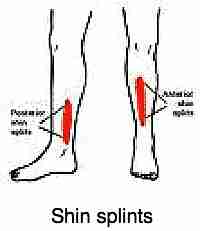
Shin Splints
Mostly it’s a self limiting condition, meaning it'll get better of its own accord with no treatment. Exercise hurts, so you stop exercising and the pain goes away. But that’s not an option for the serious athlete and those hooked on aerobics. Then the condition may become chronic and very debilitating.
Several structures attach to the inner shin bone, or tibia. The one usually affected is the soleus muscle, one of the two big calf flexors.
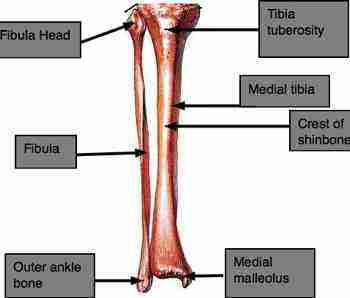
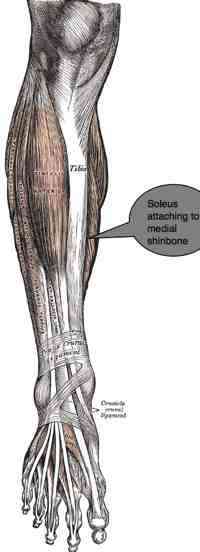
and the semi tendinosis, one of the hamstring muscles.
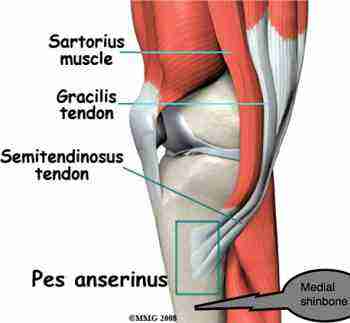
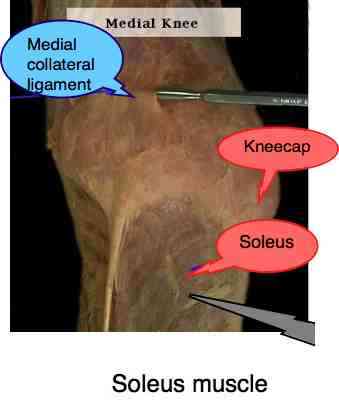
"In thigh-high yellow leather boots
Plump Saphonisba strides.
Too bad that, just to hide her calves,
Two calves have lost their hides."
- X. J. Kennedy
Chiropractic Help
Enter the chiropractor. We like to treat the causes, not just the symptoms. So what are the causes? Frankly there are many. Hyper-pronation of the ankle is one of the main causes. Flat feet.
You can surely see the difference:
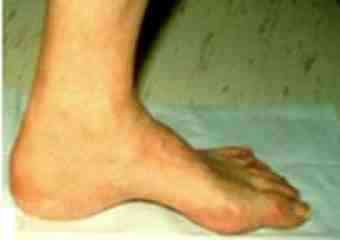
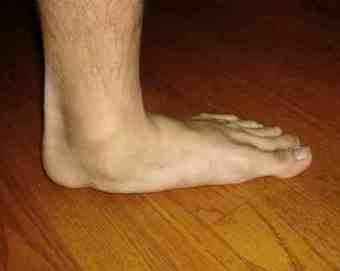
Plantar myofascitis is another feature of so many folk's feet.
A bit of anatomy
However there are many other causes from tight calf muscles, the soleus and gastrocnemius, insufficient warm up techniques and a sudden increase in training. In practice, as chiropractors we often find many other associated conditions that could be the underlying cause of your shin splints. These could be fixations in the foot or a subluxated sacroiliac joint; there is no substitute for a careful and thorough examination.
Muscles move bones, and connect to the bone via a tendon, albeit a very short tendon in the case of the Soleus, but a very long tendon of the Semitendinosus.
A ligament by the way connects bone to bone, whereas a muscle to bone connection is via a tendon.
These tendons connect to the shin bone via so called sharpey fibres that root deep into the peri osteum, around the bone, the connective tissue bone sheath, hooking the tendon firmly to the bone.
In a so called tendonitis, these fibres rip out of the bone causing pain when the muscle contracts. Often though, there is less discomfort during exercise if the athlete follows a proper warm up procedure; but, after the workout, the stabs return with a vengeance.
The pain of shin splints can be experienced anyway from just below the medial, or inner, knee, and right down to the medial malleolus of the ankle. It may be a very sharp and debilitating, often brought on after a long layoff without proper preparation for the new season.
Here's an anecdote from the coalface. A young woman in her early thirties, very active but not an athlete, consulted me recently with severe inner shinbone pain. She loved to jog, do a bit of aerobics but was hardly a fitness freak; just active.
Two and a half years ago she started getting shin splints. Within a few months it was so painful that she literally could not walk more than a hundred metres. To go op stap as young people call it in Holland, a Friday night on the town, she literally had to use crutches.
She had tried everything she told me.
It proved to be an interesting case. She had no flat feet, which is often the case, but she did have a short leg, and a fixation in the opposite sacro-iliac joint. There is pretty standard, and dealing with those alone might have fixed her problem. But what was interesting was the she had marked fixations in the medial cuneiform bone in the foot and a fibula head fixation.
The expected medial shinbone pain periosteal pain at the insertion of the soleus muscle, but also following the semitendinosus muscle way up into the thigh were present.
She is well pleased. In just three weeks the pain has halved, and last weekend she went for a stroll around the town for the first time in two years.
Treatment @ Chiropractic Help
- She had already stopped exercising, but in your case, for your shin splints you will have to temporarily stop, or drastically reduce your exercise program.
- Take a polystyrene cup, will it with water and place it in the deep freeze. Take it to the bath, and give the shin an ice massage, alternating with the hot bath. Peel away the polystyrene as needed. Rule of thumb: Alternating ice/heat after exercise, plain heat before training.
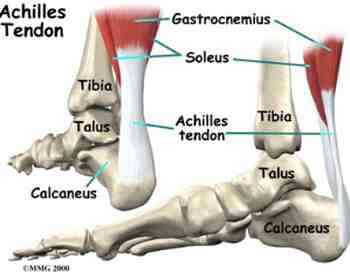
- The soleus beds into the Achilles tendon. Start a daily set of stretches. ANKLE exercises.
- After your ice/heat treatment, use a little cream and run your thumb down your shin, feeling for bumps and painful spots. Press. Don't be shy, because if it doesn't get better with your own ministrations, then you can be sure that your chiropractor is going to press pretty damn hard. In Holland we say, 'gentle healers make stinking wounds.' Whilst I don't necessarily go along with that, the treatment of tendon and muscle conditions is usually painful.
- Pain is ironically your friend. It's not good sense to take pain killers and anti-inflammatories and go out an train. Listen to your friend Mr Pain. He's trying to tell you something.
- Take this little 'wet test' to see if you have flat feet:
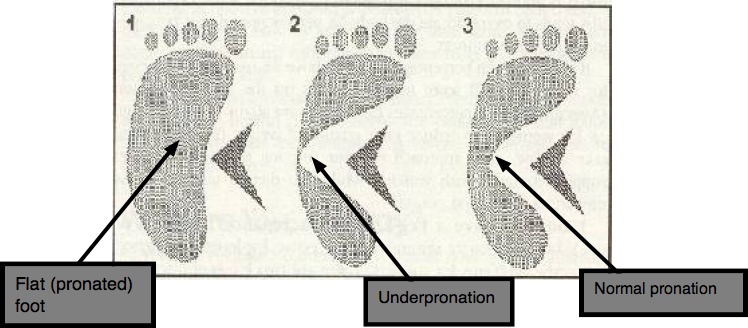
Ankle joint sprain
Underlying all your pain is often an old injury; perhaps an old sprain. Ankle sprain treatment is in effect prevention of these problems that develop later.
- You may be able to find some inners to help with foot pronation, but you may have to get a custom set made. The are expensive; try the drug store first!
- Shin splints often comes on after training on a hard underfoot. Concrete, for example. Start your training on a level grass field, like a football pitch.
- How are your shoes? Worn out? Giving enough support for your peculiar feet?!! A good set of orthotics helps with shin splints, in conjunction with treatment. Even on their own they might help.
Buying running shoes
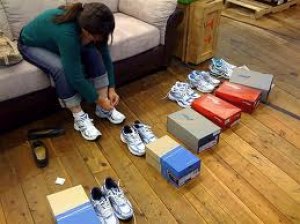
Buying the right shoe for your foot is imperative. Don't do it in a rush because the wrong shoe can certainly result in foot and ankle pain, shin splints and even knee and hip pain.
When to consult your chiropractor?
This is always a difficult question to answer. I don't believe you have to rush off to your doctor for every little snivel, or your chiropractor whenever you have a pain. Try some common sense home care for a few weeks.
But do understand that if you allow it to become chronic, you will have to go onto a rehabilitation program, and an occasional regular treatment with your chiropractor for some months, all of which starts to cost. This applies just as much to shin splints as it does to neck pain.
When you know, honestly deep down, that this is not getting better then do not delay any longer.
Tip: Make sure you find a sports oriented chiropractor for this condition. Your regular DC who only adjusts the spine will help, but his tools may prove limited. Call the chiropractic association and ask for a chiropractor with fics qualification.
BREASTBONE PAIN ... a nasty kindred spirit
Bone-bone, bone-ligament and bone-tendon conditions can all be very disheartening. Chiropractic works with all three.
Links
- Read more about Foot Pain …
- Together with Sprained ankle make kindred spirits together with shin splints.
- Go from Shin Splints to Celery Soup, a natural anti-inflammatory.
Did you find this page useful? Then perhaps forward it to a suffering friend. Better still, Tweet or Face Book it.
